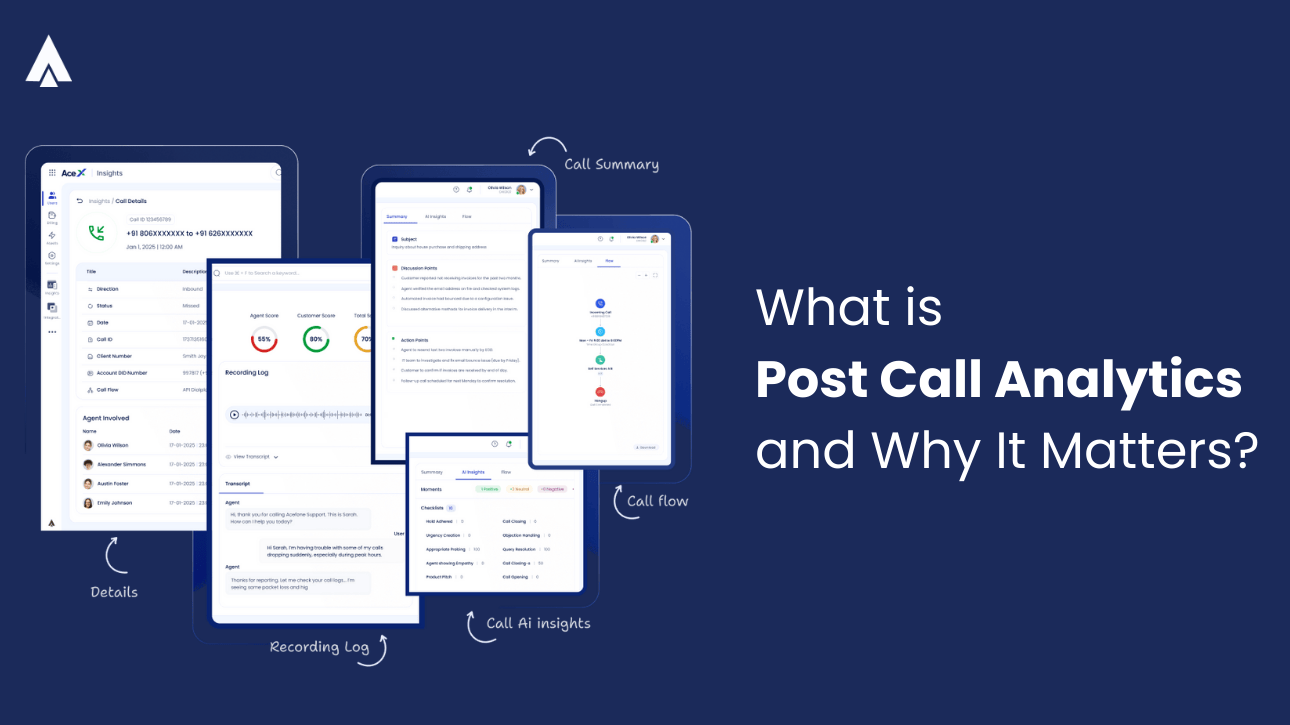Redefining Call Center Management to Enhance Customer Experience. Customer satisfaction is no longer a mere aspiration. It’s the lifeblood of modern business. In the era of referrals and branding, call centers have emerged as a critical component for businesses to win hearts.
With increasing customer expectations and technological advancements, maintaining your call center quality becomes a mandate. To fulfil this objective, call center managers must radically shift their perspective and embrace a quality-centric approach. This blog delves into the challenges and opportunities ahead, creating a blueprint for managers to elevate their call center’s performance. According to Wikipedia, Call features provide a customised experience for the caller and maximize the efficiency of inbound call handling.
What is Call Center Management?
Call center management includes strategic planning, operational oversight, and continuous optimization of customer service operations. This aim is to deliver consistent, high-quality customer interactions while achieving business objectives.
Modern call center management extends far beyond simply answering phones. Today’s contact center management involves:
- Strategic workforce planning to ensure optimal staffing levels
- Performance optimization through data-driven insights
- Technology integration to streamline operations
- Quality assurance to maintain service standards
- Customer experience design to exceed expectations
To navigate a call center management, we must first understand the intricate ecosystem in which it operates.
A outbound contact center software is a dynamic hub managing interactions between you and your customers. Traditionally they are categorized into inbound and outbound operations and are morphing into complex entities handling an increasing array of customer touchpoints.
How Does a Call Center Management Work?
A modern contact center functions as a sophisticated ecosystem where multiple components work in harmony:
The Customer Journey Flow
When a customer initiates contact, their journey follows a careful path:
- Initial Contact: Customers reach out through various channels—voice, email, or chat
- Routing Intelligence: Advanced call center management systems analyze the inquiry and route it to the most appropriate agent based on skills, availability, and historical performance
- Agent Interaction: Trained representatives handle the inquiry using established protocols and knowledge bases
- Resolution and Follow-up: Issues are resolved with proper documentation for future reference and continuous improvement
Technology Infrastructure
Modern call center process management relies on integrated technology stacks including:
- Automatic Call Distribution (ACD) systems for intelligent routing
- Interactive Voice Response (IVR) for self-service options
- Customer Relationship Management (CRM) integration for comprehensive customer views
- Workforce Management (WFM) tools for scheduling and forecasting
- Quality Management platforms for monitoring and coaching
This technological foundation enables data-driven decision-making and operational efficiency.
Types of Call Centers
Here are a few popular types of call centers that business use:
Inbound Call Center
Inbound call centers are reactive, fielding incoming calls, emails, or chats. Customers make calls to inbound call centers for numerous reasons like payments, technical support, appointment booking, etc. By leveraging advanced call routing services, these centers can ensure the calls are directed to the most relevant agents promptly. With evolving inbound call center software, customer expectations continue to rise too, pushing agents to become prompter with their responses.
Outbound Call Center
Outbound call centers specialize in proactive communication, sales outreach, surveys, revenue collection and similar ops. Running an outbound call center gets simplified as outbound call center software provides easier access to critical contact information on any device. It also enables agents to swiftly collaborate with team members remotely. Outbound centers can gain a powerful productivity edge when you understand how does an auto dialer work and apply it to campaign dialing workflows.
Omnichannel Call Center
Despite the binary distinction, inbound and outbound call centers are gradually shifting towards delivering seamless omnichannel experiences. Businesses continue to integrate phone calls, emails, SMS, and messaging channels like WhatsApp into a single platform for a unified customer journey.
By monitoring every customer interaction, from first touch point to post-purchase support, you can gain invaluable insights into the client’s challenges and opportunities. This granular understanding empowers you to optimize your call center operations, anticipate customer needs, and deliver tailored experiences. With omnichannel operations becoming standard—phone, chat, email, and messaging—understanding how does an auto dialer work can help streamline your voice outreach within this ecosystem.
Ultimately, the efficacy of your call center is measured by its impact on the bottom line. Robust suite of metrics and KPIs is essential to gauge performance. Metrics such as average handling time, first call resolution, CSAT scores, and agent turnover provide critical data points for identifying trends, measuring efficiency, and driving improvement.
Key Call Center Management Roles and Responsibilities
Successful call center management requires clearly defined roles and responsibilities across multiple organizational levels. Understanding these roles is essential for building an effective management structure:
1. Call Center Director/VP of Customer Operations
Strategic Responsibilities:
- Developing long-term customer experience strategies aligned with business objectives
- Budget planning and resource allocation for optimal ROI
- Stakeholder communication and performance reporting to executive leadership
- Technology roadmap planning and vendor relationship management
Key Performance Indicators:
- Customer satisfaction scores (CSAT, NPS)
- Cost per contact and operational efficiency metrics
- Employee engagement and retention rates
- Revenue impact and customer lifetime value
2. Call Center Manager/Operations Manager
Operational Responsibilities:
- Daily operations oversight and team leadership
- Performance management and coaching programs
- Workflow optimization and process improvement initiatives
- Compliance monitoring and quality assurance
Core Competencies:
- Data analysis and performance interpretation
- Team leadership and conflict resolution
- Process improvement and change management
- Customer experience optimization
3. Team Leaders/Supervisors
Front-line Responsibilities:
- Real-time performance monitoring and support
- Individual agent coaching and development
- Escalation handling and customer issue resolution
- Schedule adherence and workforce management
- Quality Assurance Specialists
Quality Management Responsibilities:
- Call monitoring and evaluation against established standards
- Training program development and delivery
- Performance trend analysis and reporting
- Continuous improvement recommendations
These roles work collaboratively to ensure your call center management system operates at peak efficiency.
Call Center Management Best Practices
Implementing proven best practices transforms operational efficiency and customer satisfaction. Based on industry research and successful implementations across various sectors, these practices deliver measurable results:
1. Implement Comprehensive Performance Management
Data-Driven Approach: Establish clear, measurable KPIs that align with business objectives. Key metrics include:
- First Call Resolution (FCR) rates
- Average Handle Time (AHT) balanced with quality
- Customer Satisfaction (CSAT) scores
- Net Promoter Score (NPS)
- Employee satisfaction and retention rates
Regular Performance Reviews: Conduct weekly team performance reviews and monthly individual assessments. Use data visualization tools to make performance trends easily understandable for all stakeholders.
2. Invest in Agent Development and Training
Continuous Learning Programs: Modern customers expect knowledgeable, empathetic service. Implement:
- Comprehensive onboarding programs (typically 3-4 weeks)
- Ongoing skills development workshops
- Product knowledge updates
- Soft skills training focusing on emotional intelligence
Career Advancement Pathways: Create clear progression opportunities to reduce turnover and improve job satisfaction.
3. Leverage Technology for Operational Excellence
Call Center Management Software Integration: Deploy integrated platforms that provide:
- Real-time dashboards for performance monitoring
- Predictive analytics for workforce planning
- Automated quality monitoring and coaching alerts
- Customer journey mapping and analytics
Omnichannel Capabilities: Ensure seamless customer experiences across all touchpoints.
4. Focus on Employee Experience
Work Environment Optimization: Create a positive workplace culture through:
- Flexible scheduling options when possible
- Recognition and reward programs
- Wellness initiatives and mental health support
- Regular feedback and communication channels
Empowerment and Autonomy: Provide agents with decision-making authority within defined parameters. Empowered agents resolve issues 34% faster and achieve higher customer satisfaction scores.
5. Implement Proactive Quality Management
Real-time Monitoring: Use advanced analytics to identify potential issues before they escalate:
- Sentiment analysis to detect customer frustration
- Agent performance alerts for immediate coaching
- Call flow optimization based on real-time data
Continuous Improvement Culture: Establish regular review cycles to assess and improve:
- Process effectiveness and efficiency
- Technology performance and utilization
- Training program effectiveness
- Customer feedback integration
Contact Center Management Tips
As a leader, your strategic approach to contact center management directly influences organizational success. These insights will help you drive meaningful improvements:
Strategic Workforce Planning
Forecasting Excellence: Accurate demand forecasting reduces costs while maintaining service levels. Implement:
- Historical data analysis combined with business intelligence
- Seasonal adjustment models for predictable fluctuations
- Real-time adjustment capabilities for unexpected volume changes
Skills-Based Routing: Maximize first-call resolution by matching customers with the most qualified agents.
Technology Investment ROI
Platform Integration: Evaluate your current technology stack for integration opportunities. Siloed systems create inefficiencies and poor customer experiences. A unified platform approach typically delivers:
- Reduced average handle time
- Improved agent productivity
- Increased customer satisfaction scores
AI and Automation: Strategically implement artificial intelligence to handle routine inquiries while freeing agents for complex problem-solving. Start with:
- Chatbots for frequently asked questions
- Automated call classification and routing
- Predictive analytics for proactive service
Financial Management
Cost Optimization: Balance service quality with operational efficiency through:
- Activity-based costing to understand true interaction costs
- Vendor management and contract optimization
- Energy and facility cost management
Revenue Generation: Transform your contact center from cost center to profit driver:
- Cross-selling and upselling training programs
- Customer retention initiatives
- Voice of customer programs to drive product improvements
Change Management
Organizational Alignment: Ensure your contact center strategy aligns with broader business objectives:
- Regular stakeholder communication and reporting
- Cross-functional collaboration with sales, marketing, and product teams
- Customer experience metrics integration into executive dashboards
Culture Development: Foster a customer-centric culture throughout your organization:
- Leadership visibility and engagement
- Success story sharing and celebration
- Customer feedback integration into decision-making processes
Workflow Optimization
Process Mapping: Document current state workflows to identify improvement opportunities:
- Customer journey mapping across all touchpoints
- Agent workflow analysis for efficiency gaps
- Handoff procedures between departments
- Escalation paths and decision trees
Standardization with Flexibility: Create consistent procedures while allowing for situational adaptation:
- Core scripts with personalization guidelines
- Standard operating procedures with exception handling
- Decision-making frameworks for complex scenarios
- Quality Assurance Framework
Multi-dimensional Quality Assessment: Implement comprehensive quality evaluation covering:
- Technical accuracy and compliance
- Customer interaction quality and empathy
- Process adherence and efficiency
- Problem-solving effectiveness
Calibration and Consistency: Ensure quality standards are applied consistently:
- Regular calibration sessions between evaluators
- Clear scoring criteria and examples
- Dispute resolution processes
- Continuous refinement of quality standards
Curious about how a call center is structured at its core? Learn what is a call center and explore how people, processes, and technology align in its operation.
Conclusion
Effective call center management demands a strategic balance of human capital, technological infrastructure, and customer satisfaction. Prioritizing customer experience, investing in agent development, leveraging data-driven insights, and fostering a positive work culture are essential components of successful call center operations. The right contact center software or call center software can streamline processes and enhance overall business communication.
FAQs
While multiple metrics matter, First Call Resolution (FCR) is often considered the most impactful, as it directly affects customer satisfaction, operational costs, and agent productivity. However, the best approach is a balanced scorecard including FCR, CSAT, AHT, and employee engagement metrics.
Focus on process optimization, self-service options, and agent empowerment. Implementing skills-based routing, improving first-call resolution, and investing in agent training typically deliver cost reductions while improving customer satisfaction.
Essential features include real-time dashboards, workforce management capabilities, quality monitoring tools, CRM integration, omnichannel support, and robust reporting and analytics. The specific needs vary by organization size and industry.
Inbound centers focus on customer service, technical support, and reactive assistance, requiring strong problem-solving skills. Outbound centers emphasize sales, lead generation, and proactive customer engagement, requiring different metrics and management approaches. Many modern centers operate hybrid models.














